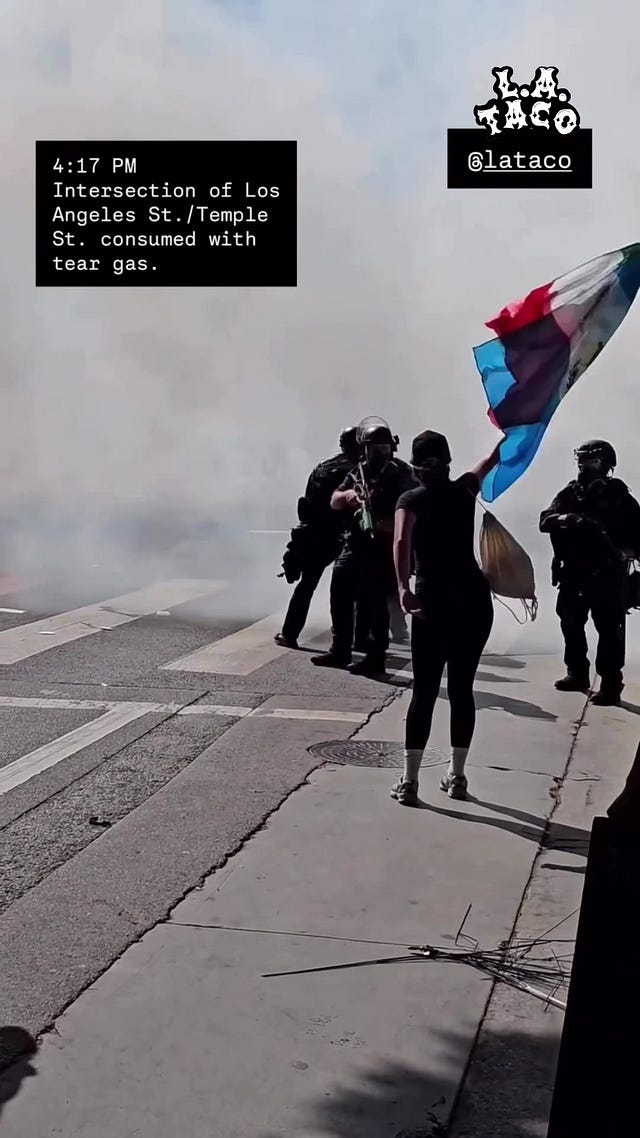How tear gas impacts our health & environment
Understanding the very real effects of "non-lethal" weapons
The first time I encountered tear gas, I was in Istanbul in 2013. I had prepared myself for this possibility—after all, the brutal government response against Gezi Park protestors had begun before I had even arrived in the city. But, the experience was still a shock to my system. Feeling the pain receptors in my eyes, nose, mouth and lungs activate triggered the first wave of fear. Suddenly finding myself in a crowd of people trampling their way to safety provoked a second wave of panic.
I, like most of the others I ran through those cobblestone streets with, hadn’t been at a protest when the gas arrived. I’d been at a cafe at least a mile away from the epicenter of action, eating a sandwich. But, state violence against protestors doesn’t exist in a vacuum, and the impacts of tear gas can be far-reaching.
When did the U.S. government start using tear gas?
The United States government was initially unsure about using tear gas—especially on U.S. soil. This changed in 1921, when President Warren Harding’s Secretary of War began recommending the weapon. The government produced a set of guidelines titled, “Provisional Instructions for the Control of Mobs by Chemical Warfare.” The document noted that at high concentrations these weapons could, in fact, become lethal, and advised that:
“A white phosphorus smoke bomb should never be shot into a mob…unless conditions have become so grave as to require treating the mob as one would treat enemy troops.”
It is perhaps worth noting that shortly after these guidelines were drafted, Congress passed its strictest immigration bill to date, establishing significant quotas for nonwhite immigrants, and those coming from eastern and southern Europe. When signing the bill, President Coolidge allegedly said, “America must be kept American.”
Health concerns
The majority of research studies done on the physical health impacts of tear gas were conducted from the 1950s-1970s on new police and military recruits—subjects who were young, male, and met certain physical fitness standards. These are the studies that were used to confirm the safety of these “non-lethal” weapons.
In the decades since, law enforcement officers have added compounds to tear gas, and have developed technologies that allow the weapon to be deployed for longer distances at higher concentrations. Newer research now suggests that tear gas can cause chronic health complications—from dermatitis and asthma to gastrointestinal issues, headaches, hair loss, unexpected heavy menstrual periods, and miscarriages.
“J,” who lived and worked near downtown Portland in 2020 and helped protestors navigate their way out of tear gas, told me that everyone she was with experienced respiratory symptoms, and many exhibited unusual menstrual symptoms. “There were women in the 20’s starting to go through menopause [and] trans men who had been on hormones for years who got their periods for the first time in a decade.” J experienced unusually heavy menstrual periods in 2020, and was later determined to be infertile at age 34. “I've been telling my friends in LA that if you're trying to get pregnant…and you're going to a place that's been getting gassed, maybe think again,” she said.
At close proximity, tear gas can cause loss of vision and nerve or brain damage. One study also found that people exposed to tear gas were more likely to contract acute respiratory infections, like the flu and Covid-19. If many of these physical impacts sound familiar, it might be because they mirror some of the health effects of wildfire smoke. I just so happen to live in a city that has experienced both in the past six months. I fear our bodies may, in fact, be keeping the score.
Since the majority of studies don’t account for how tear gas impacts diverse populations, it’s difficult to say who’s most at risk. But, experts warn that children, people who smoke, and people with asthma may be more likely to experience severe impacts. Shorter people may also feel it more, since tear gas tends to linger closer to the ground.
It’s also important to note that encountering tear gas often comes along with a psychological impact. “I worry about people not realizing that you can get PTSD from this happening,” said J. “And then there’s often a fear—at least for me—in finding a therapist who you can safely talk to about it.”
Environmental concerns
In Seoul in the 1980’s, residents of neighborhoods nearby protests where tear gas had been deployed reported persistent respiratory symptoms for weeks afterward. Similar anecdotes were recorded in Turkey in 2014. In Portland in 2020—the city where tear gas was deployed the most that summer—some people said they felt the effects of tear gas just from sitting on grass where it had previously been released.
That same summer, the Portland Department of Environmental Services sampled material collected from storm drains in areas near protests, and found elevated levels of barium, copper, lead, and zinc. Like in Los Angeles, Portland’s storm drains connect to natural bodies of water: The Willamette River, which flows out into the Pacific Ocean through the Columbia River. This means chemicals from tear gas may have impacted the ocean and marine life, as well as local agriculture.
A coalition of environmental groups, represented by the ACLU, went on to sue the Department of Homeland Security in the fall of 2020, arguing that their use of tear gas violated the National Environmental Policy Act (NEPA).
How to protect yourself
When we consider protection from tear gas, we’re once again thinking in terms of mitigation. As we’ve seen, if you live or work near an area that is being repeatedly being tear gassed, it can be difficult to avoid any encounters with these chemicals—even if you are not joining in protests. That being said, the amount and extent of your exposure matters, as do the steps you take afterward to protect yourself and others.
Understanding personal protective equipment (PPE)
As we learned during the fires this winter in LA, N95 respirators are helpful to a degree, but cannot block out all dangerous vapors. The best masks for protecting against tear gas are full-face respirators with organic vapor / acid gas cartridges (regular particle filters won’t do). The MIRA CM-7M, Mestel SGE 150, or the Dräger FPS 7000—which has its own self-contained breathing apparatus that circulates air—are quite expensive. But in addition to protecting you, these masks can help you direct others to safety. Cheaper alternatives, like the 3M 6800 with combination cartridges for particulate and gas/vapor filtration, or a half-face mask from 3M’s 6000 or 7500 series with appropriate filters, will also offer a good deal of protection.
If using a half-face respirator, it’s best to also wear shatter-proof goggles, such as those used for snowboarding, swimming, or construction. But, make sure any vents on the goggles are filled in, and that the respirator and eyewear aren’t overlapping—as this can prevent a clean seal.
Wearing long-sleeved shirts and pants can help prevent against some of the dermatological impacts of tear gas. Some scientists also believe you should avoid wearing lotions or sunscreen, which may amplify the impacts of tear gas on your skin.
Avoid wearing contact lenses, as they can make it harder to flush chemicals from your eyes if they enter.
Redirecting, extinguishing, and cleansing
If you are wearing PPE, and are equipped to do so, you can attempt to redirect tear gas with a leaf blower. Sometimes an umbrella can help, too.
You can disabled a tear gas canister by pouring water over it. However, a lot of water may be needed if the canister is not tiny in size. J says putting a traffic cone or similar item on top of a canister that you’ve poured water on can help, as well.
If you are hit, medical professionals say water, soap, and fresh air is the best remedy for flushing out your eyes—as opposed to milk or baking soda mixtures.
If gas gets into your house, use lots of soap and water to wipe down the surfaces of your home, and throw out any food that wasn’t sealed away.
Practicing aftercare
Before entering your home, remove any outer clothing or gear that may have been exposed to gas. This will prevent you from accidentally releasing more chemicals into your home when you disrobe. J also recommends putting your hair up before you enter your house if you have long hair that may have gotten contaminated.
Wipe down shoes and glasses, and wash clothes.
It’s important to shower or wash—in water that isn’t hot—after exposure. This will prevent further skin irritation.
Hydrate, rest, and create space to emotionally decompress, if possible. J found it helpful to be able to process her days at protests with peers who had been there, too. “Remember your mental health,” she said. “Remember that it could hit a long time from now [but] that there are communities of people that have been through this, and can support.”
Monitor for long-term symptoms. Some people have described feeling “hungover” afterward, short of breath, or fatigued for as long as weeks after an encounter, in addition to more complex chronic symptoms.
Taking breaks
State sanctioned violence creates trauma of all kinds, and taking breaks—if it’s available to you—is important for sustaining your ability to engage in long-term resistance. Maybe that means leaving the impacted zone for a weekend, if you can, or creating a plan that includes periods of rest inside a well-sealed, uncontaminated, indoor area. J reminded me that off-the-ground support is as crucial a contribution as being on the streets in-person.
“I did have to eventually learn that fighting fascism is not a sprint, it's a marathon,” J said. “While not every protest will end in rubber bullets [and] tear gas, my experience is that as the number of protest days grows, so does the trigger-happiness of the entities policing the protest.”
Learning to take breaks during increasingly urgent feeling times is a truly difficult task, and one I grapple with daily. But, I’ve been finding that the communities I formed before and during the LA fires are what is helping me sustain my engagement. When I step back, someone else is often able to step forward. And, I believe we’re slowly settling into roles that best serve our individual needs and skills.
“I encourage all bodies to remember that this is not normal,” J said. “Give yourself [and] each other grace as we learn what our individual roles [and] limits are in a landscape where unreasonable violence has no bounds.”
As always, stay safe out there.
CJ Mattia contributed research to this article.
safety pin publishes about once a month, sharing written and audio work on the intersections of climate change, chronic illness, and disability justice. If you value this work, please consider becoming a paid subscriber. It also helps to like our posts, and become a free subscriber :)
Unfortunately this app doesn’t allow sliding scale subscriptions, so if you’d like to contribute at a lower fee than $5 per month or $55 per year, you can make a one-time donation via venmo (@ fionalowenstein), or set up recurring monthly donations at Zelle (fionalowenstein@gmail.com). Funds go toward compensating our podcast producer, covering operational costs like Zoom and paid transcription services, and will hopefully allow me to eventually pay myself fairly for this work and bring in other talented trans and/or disabled collaborators.







